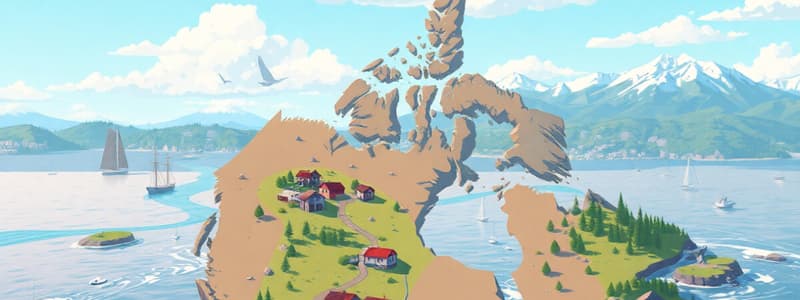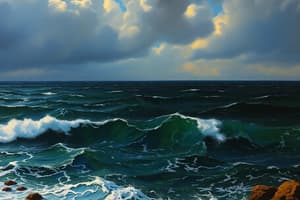Podcast
Questions and Answers
The Atlantic region's valleys are known for their rich and ______ soil, which supports agricultural activities.
The Atlantic region's valleys are known for their rich and ______ soil, which supports agricultural activities.
fertile
Although the Atlantic region accounts for only 10% of Canada's population, it has the ______ population density of all provinces.
Although the Atlantic region accounts for only 10% of Canada's population, it has the ______ population density of all provinces.
highest
Besides cod fishing, the Atlantic region's economy relies on forestry, with pulp and paper being exported to Europe and the United States, along with farming, which includes vegetables, dairy, and apples in Nova Scotia's ______ Valley.
Besides cod fishing, the Atlantic region's economy relies on forestry, with pulp and paper being exported to Europe and the United States, along with farming, which includes vegetables, dairy, and apples in Nova Scotia's ______ Valley.
Annapolis
The St. Lawrence River region is comprised of two lowland areas in Ontario and Quebec, separated by a thin arm of the Canadian Shield, known as the ______ Axis, which crosses the lowlands near Kingston, Ontario.
The St. Lawrence River region is comprised of two lowland areas in Ontario and Quebec, separated by a thin arm of the Canadian Shield, known as the ______ Axis, which crosses the lowlands near Kingston, Ontario.
In the Great Lakes-St. Lawrence River region, the largest First Nations band in Canada, known as the ______ Nations, resides around the Grand River in Ontario.
In the Great Lakes-St. Lawrence River region, the largest First Nations band in Canada, known as the ______ Nations, resides around the Grand River in Ontario.
Agriculture in the St. Lawrence River region is naturally suited due to good soil, abundant water, and a long growing season, but the expansion of potential industry poses a threat of ______ farmland.
Agriculture in the St. Lawrence River region is naturally suited due to good soil, abundant water, and a long growing season, but the expansion of potential industry poses a threat of ______ farmland.
The Shield Region, characterized by its U-shape, touches all of Canada's provinces and territories except those in the ______ Region.
The Shield Region, characterized by its U-shape, touches all of Canada's provinces and territories except those in the ______ Region.
The Canadian Shield is characterized by a wealth of Precambrian ______, making it a significant source of various minerals.
The Canadian Shield is characterized by a wealth of Precambrian ______, making it a significant source of various minerals.
Unlike other regions, the Canadian Shield is one of the ______ populated areas in Canada, with many communities in rural areas.
Unlike other regions, the Canadian Shield is one of the ______ populated areas in Canada, with many communities in rural areas.
While natural resource extraction is significant, the Canadian Shield sees limited ______ and agriculture.
While natural resource extraction is significant, the Canadian Shield sees limited ______ and agriculture.
The Interior Plains are situated between the Canadian Shield and the Cordillera region, forming part of a vast ______ that extends from the Arctic to the Gulf of Mexico.
The Interior Plains are situated between the Canadian Shield and the Cordillera region, forming part of a vast ______ that extends from the Arctic to the Gulf of Mexico.
In the Interior Plains, farming and ______, particularly wheat production and beef cattle ranching, are vital economic activities.
In the Interior Plains, farming and ______, particularly wheat production and beef cattle ranching, are vital economic activities.
The Cordillera region, characterized by its mountainous terrain, is known for dependence on the sale of ______ materials rather than manufacturing finished products.
The Cordillera region, characterized by its mountainous terrain, is known for dependence on the sale of ______ materials rather than manufacturing finished products.
The northern region of Canada is defined by its location above the line of continuous ______, an environmental characteristic that influences its landscape and infrastructure.
The northern region of Canada is defined by its location above the line of continuous ______, an environmental characteristic that influences its landscape and infrastructure.
Mining activities in Canada's northern region have increased because of the discovery of minerals such as ______, zinc, and iron ore.
Mining activities in Canada's northern region have increased because of the discovery of minerals such as ______, zinc, and iron ore.
Flashcards
Atlantic Region Boundaries
Atlantic Region Boundaries
New Brunswick, Nova Scotia, Newfoundland, P.E.I., and parts of Quebec.
Atlantic Region Population
Atlantic Region Population
Accounts for about 10% of Canada's total population.
Atlantic Region Economy
Atlantic Region Economy
Cod fishing, forestry, farming (dairy, apples, potatoes), and mining (lead, zinc, copper, coal) and tourism.
St. Lawrence Region Boundaries
St. Lawrence Region Boundaries
Signup and view all the flashcards
St. Lawrence Region Population
St. Lawrence Region Population
Signup and view all the flashcards
St. Lawrence Region Economy
St. Lawrence Region Economy
Signup and view all the flashcards
Shield Region Boundaries
Shield Region Boundaries
Signup and view all the flashcards
Shield Region Resources
Shield Region Resources
Signup and view all the flashcards
The Shield Region
The Shield Region
Signup and view all the flashcards
The Plains Region
The Plains Region
Signup and view all the flashcards
The Cordillera Region
The Cordillera Region
Signup and view all the flashcards
The North Region
The North Region
Signup and view all the flashcards
Shield Economy
Shield Economy
Signup and view all the flashcards
Plains Economy
Plains Economy
Signup and view all the flashcards
Cordillera Economy
Cordillera Economy
Signup and view all the flashcards
North Economy
North Economy
Signup and view all the flashcards
Study Notes
Atlantic Region - Political Boundaries
- Encompasses New Brunswick, Nova Scotia, Newfoundland, Prince Edward Island (PEI), and parts of Quebec.
- Characterized by valleys with rich, fertile soil.
- Features banks off the coast that are conducive to good fishing.
Atlantic Region - Population and Cities
- Accounts for 10% of Canada's total population.
- Experiences the highest population density among all provinces despite the relatively small area.
- Densely populated, with residents mainly living in cities and working primarily in manufacturing and service industries.
Atlantic Region - Economy
- Historically reliant on cod fishing as a primary natural resource.
- Forestry is a key industry, focusing on pulp and paper production for export to Europe and the U.S.
- Agriculture includes vegetable and dairy farming.
- The Annapolis Valley in Nova Scotia is known for apple production.
- PEI is noted for potato farming in its red soil.
- Mining yields lead, zinc, copper, and coal.
- Newfoundland benefits from offshore oil deposits.
- Tourism contributes significantly to the regional economy.
St. Lawrence River Region - Political Boundaries and Physical Region
- Includes two lowland areas of Ontario and Quebec.
- Separated by a thin arm of the Canadian Shield known as the Frontenac Axis, which crosses the lowlands near Kingston, Ontario.
- The Frontenac Axis runs north from Niagara Falls to Tobermory, Ontario.
- Characterized by rich soils, the Great Lakes, and the St. Lawrence River.
Great Lakes - St. Lawrence River Region - Population and Cities
- Originally inhabited by two First Nations: the Algonkians and the Iroquoians.
- The Six Nations, the largest Indian band in Canada, resides around the Grand River, Ontario.
- Includes Aboriginal people who live and work in relocated towns and cities.
- The French settled along the lower part of the St. Lawrence River.
- Predominantly urban, with most of the region's inhabitants living in cities.
St. Lawrence River - Economy
- Naturally suited to agriculture due to good soil, abundant water, and a long growing season.
- Agricultural products serve as a food supply for the local population, with some processed for sale.
- Faces loss of farmland due to potential industry expansion on valuable agricultural land.
- Produces a variety of manufactured goods, including iron, automobiles, and clothing.
- Benefits from extensive transportation links and a developed highway network, facilitating raw material transport.
The Shield Region - Political Boundaries
- Touches all of Canada's provinces except for the Atlantic provinces(New Brunswick, Nova Scotia, newfoundland, P.E.I, and parts of quebec)
- Underlined by hard, ancient Precambrian rock.
- U-shaped geographic formation.
- Rich in minerals such as lead, gold, copper, zinc, and uranium.
- Extensively affected by the Ice Age, leaving deposits of rock, soil, and gravel.
The Shield - Population and Cities
- Originally settled by the Algonkians and Inuit.
- Indigenous groups include the Cree, Ojibway, Naskapi, and Montagnais.
- Least densely populated region in Canada.
- Predominantly settled in rural areas.
The Shield - Economy
- Trees are processed into lumber and shipped overseas.
- Rich in metallic and nonmetallic minerals.
- Forestry and logging significantly impact the economy.
- Heavily dependent on the extraction of natural resources.
- Has limited manufacturing and agriculture, confined to small pockets of fertile areas.
- Hydroelectricity production is significant .
The Plains - Political and Physical
- Located between the Shield and the Cordillera regions.
- Part of a larger plain stretching from the Mexican border.
- Predominantly hilly terrain.
The Plains - Population
- Two-thirds of the population resides in towns and cities.
- Over 170 First Nation bands have claims against the government.
The Plains - Economy
- Farming and ranching are important.
- Wheat is a main cash crop.
- Ranching for beef production is significant.
- Large oil reserves were discovered after World War II, predominantly in Alberta.
- Deposits of potash and coal are important mineral resources.
The Cordillera Region - Political and Physical
- Located on the west coast.
- Includes most of British Columbia, Yukon, and parts of Alberta and the Northwest Territories.
- Well-known for its mountainous terrain.
The Cordillera Region - Population and Cities
- Includes seven main indigenous groups.
- Home to the second-largest Aboriginal population in Canada.
- Approximately three-quarters of the population lives in cities and towns.
- Features a diverse cultural makeup.
- Experienced significant immigration starting in 1858.
The Cordillera Region - Economy
- Mining is a crucial sector, with metallic minerals being the most valuable.
- Non-metallic minerals are important for construction.
- Known for diverse rock types.
- Farming produces fruits and vegetables.
- Salmon fishing is a key industry.
- Forests of immense trees are a valuable resource.
- Faces conflicts over forest exploration.
- Problems include reliance on the sale of raw materials rather than manufacturing value-added products.
The North Region - Political Boundaries
- Located above the line of continuous permafrost.
- Borders the Arctic Ocean and Hudson Bay.
- Features plateaus, mountains, and lowlands.
- Precambrian rock, similar to that in the Shield, is found in the Arctic Islands.
The North Region - Population and Cities
- Early European settlements were driven by the fur trade
- Gold discoveries in the Yukon and subsequent mining activities brought settlements.
The North Region - Economy
- Trapping and fishing formed the basis of the economy for many years.
- Trade has increased over time.
- Significant mineral resources have been discovered.
- Metallic minerals, including zinc, iron ore, lead, and diamonds, are present.
Studying That Suits You
Use AI to generate personalized quizzes and flashcards to suit your learning preferences.
Description
Explore Canada's Atlantic Region, including its political boundaries, population distribution, and key industries. Learn about its fertile valleys, rich fishing banks, and the economic reliance on natural resources like cod fishing and forestry. Discover the agricultural contributions of Nova Scotia's Annapolis Valley and PEI.




